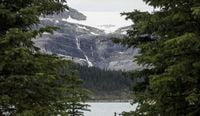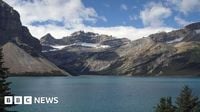Tragedy struck Banff National Park on Thursday afternoon, June 19, 2025, when a massive rockfall near Bow Glacier Falls claimed the lives of two hikers and injured three others. The incident unfolded on a popular trail that winds along the edges of Bow Lake, a scenic area known for its turquoise waters and towering mountain backdrop, drawing thousands of visitors each year.
The first victim, a 70-year-old Calgary resident identified as retired University of Alberta educator Jutta Hinrichs, was found dead at the scene. Hinrichs, a respected leader in the Faculty of Rehabilitation Medicine's Department of Occupational Therapy, had recently retired in July 2024. The university described her as a "dedicated leader and educator" whose legacy continues to enrich occupational therapy in Alberta. The second body was recovered the following day, June 20, 2025, after search-and-rescue teams located it on Thursday but could not safely retrieve it due to unstable conditions. Authorities have withheld the identity of the second victim pending family notification.
Three other hikers sustained injuries serious enough to require hospital treatment. Two were airlifted by STARS helicopters from Calgary and Edmonton, while the third was transported by ground ambulance. All were reported in stable condition as of Friday. Emergency responders, including Parks Canada, RCMP, Lake Louise fire department, and EMS, swiftly arrived at the scene following the initial report around 1:30 p.m.
Witnesses described a terrifying and surreal scene. Niclas Brundell, a trail guide from nearby Canmore, was hiking with his wife when he noticed early signs of instability. "We heard this like 'chunk' noise and the whole roof of the wall came loose," he recounted. As the mountainside began to collapse, Brundell saw a slab roughly 50 meters wide and 20 meters deep detach, sending boulders tumbling. He watched in horror as a group of 15 to 30 people at the waterfall vanished under a cloud of dust. He likened the scene to "watching videos from 9-11, when you see New York being cast over." Brundell and his wife sprinted to safety, with him sending a satellite message to Parks Canada and his wife seeking help at a nearby lodge.
Another witness, Elly Jackson, narrowly escaped with minor injuries. Hiking solo with her dogs, she heard a cracking sound and saw what she described as a "multi-storey building — a huge slab of rock" falling. "My instant thought was, 'I can't survive that,'" she said. Dropping her backpack and camera, she ran downhill as fast as she could, even after falling. Once at a safe distance, she returned to help tend to the injured, joining strangers in triaging and moving victims away from the unstable cliffs while awaiting emergency crews. "People were just in shock," Jackson recalled. "Some were blaming themselves and not dealing with it too well." Their quick actions likely saved lives during the agonizing wait for professional responders.
Following the rockfall, Parks Canada, joined by Canada Task Force Two (CAN-TF2 Calgary) and the Calgary Police Service, conducted an extensive overnight search using infrared-sensing drones and thermal imaging cameras. They found "no indication of human presence" in the debris and confirmed no additional missing persons or unidentified vehicles at the trailhead. In total, 13 people, including bystanders, were evacuated from the area.
François Masse, superintendent for Banff National Park's Lake Louise, Yoho, and Kootenay field units, called the event "extremely rare" and "neither preventable nor predictable." While rockfalls are common in the Rockies due to water entering fissures and freezing—causing cracks to expand and rocks to tumble—the size of the detached slab in this incident was exceptional. Masse noted that rainy conditions in the days prior may have contributed to the instability, although Thursday itself was sunny. The area is now anticipating snowfall, adding urgency to the assessment of ongoing risks.
The Bow Glacier Falls trail, about 2.7 miles (4.3 kilometers) one way and rated moderate in difficulty by Parks Canada, remains closed indefinitely due to concerns about remaining instability in the rock face. Nearby Bow Lake and the trail to Bow Hut have since reopened. A geotechnical engineer has been dispatched to survey the slope and evaluate the potential for further rockslides.
This tragic rockfall is at least the second significant event near Bow Glacier Falls in recent years. In August 2023, a smaller rockfall injured several hikers and required one tourist to be airlifted after cuts and bruises, highlighting the ongoing natural hazards in the region.
Ron Hallman, president and CEO of Parks Canada, expressed deep sorrow over the incident. "We are all heartbroken by the recent tragedy at Bow Glacier Falls in Banff National Park. On behalf of Parks Canada, my thoughts are with the families and friends of those who are affected," he said.
Canadian Prime Minister Mark Carney also offered condolences during a news conference in Ottawa on Friday. "I want to address the tragedy at Bow Glacier Falls, and offer my condolences to the loved ones of those who have lost their lives in this tragic accident. And wish a full recovery to all those injured," he stated.
As Banff National Park continues to attract millions of visitors each year, this incident serves as a sobering reminder of the unpredictable power of nature in mountain environments. While the rockfall was an extraordinary event, it underscores the importance of vigilance and respect for the inherent risks present on even well-traveled trails.





